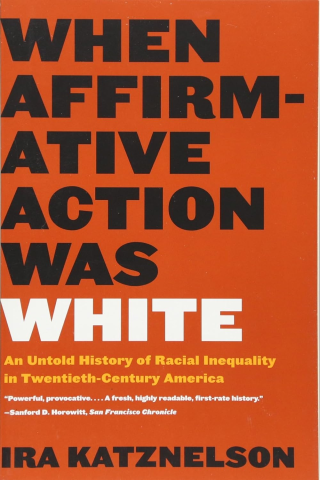First published in 2005, my book When Affirmative Action Was White answered a question Lyndon Johnson posed at Howard University’s graduation ceremony in June 1965: Why had the large gap between Black and white income and wealth at the end of World War II widened during two decades marked by dramatic economic growth and widespread prosperity?
The book told the story of sanctioned racism during and just after the Great Depression and World War II. During this period, master politicians from the South proudly protected their region’s entrenched white supremacy by passing landmark laws that made the great majority of Americans, the overwhelming white majority, more prosperous and more secure, while leaving out most African Americans, in full or in part. Ever since, many persons left behind have continued to experience deep poverty, together with social and spatial isolation.
The book’s account of blatant discrimination has been challenged in the seventeen years since it appeared. Two lines of argument are especially noteworthy. One questions whether domestics and farm laborers—critical categories of Black employment—were in fact kept out of Social Security for reasons of race. The second argues that the book underestimates the bounty of the GI Bill for Black Americans. Both objections deserve respectful review.
Taking up the story of the exclusion of agricultural and domestic workers in the Social Security Act, some critics argue that an alternative explanation is more compelling. Among earlier counterpart legislation in Europe and Canada, comparable programs often had excluded farmworkers and maids for practical, not racial, reasons. New Deal policy leaders knew this history and were acquainted with many overseas experts who had drafted social insurance legislation.
This alternative story is not without merit. Within the Roosevelt administration, Secretary of the Treasury Henry Morgenthau did express skepticism about including domestics and farmworkers. His concerns were technical. Manifestly, it is more difficult to keep track of persons with these often ephemeral jobs than of individuals whose work is more fixed and persistent.
Nonetheless, the legislative history of the Social Security Act supports the race-centered argument. The basis for congressional action, report by President Franklin Roosevelt’s Committee on Economic Security, unambiguously stated, “We are opposed to exclusions of any specific industries within the Federal act.” Focusing on persons at the bottom of the wage scale, the document explicitly stressed that “agricultural workers, domestic servants, [and] home workers” must be included. Following this explicit advice, the bill the White House sent to Congress included these groups.
